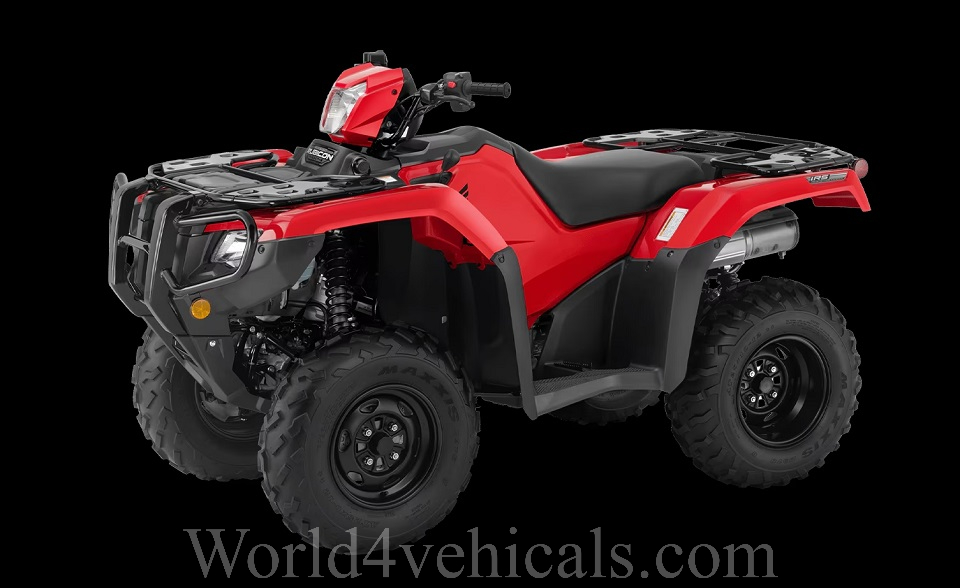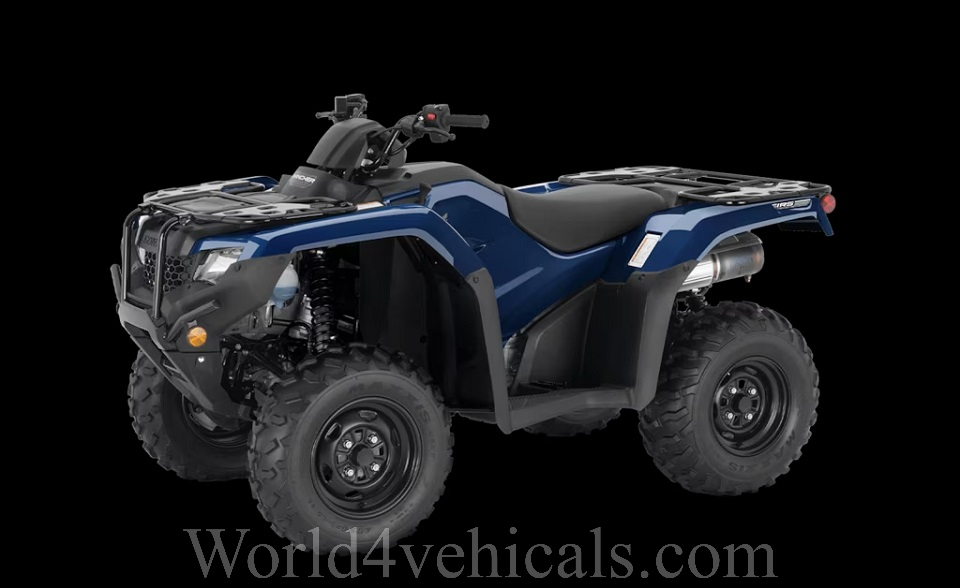Introduction
The FourTrax Foreman Rubicon, engineered by Honda, represents a pinnacle of all-terrain vehicle (ATV) design, integrating advanced mechanical systems to enhance both performance and durability. This ATV is meticulously constructed to navigate rugged landscapes, facilitate demanding labor, and optimize rider control. With a focus on efficiency, longevity, and adaptability, the FourTrax Foreman Rubicon is widely regarded as a premier choice for agricultural, industrial, and recreational applications.

This technical overview examines the vehicle’s structural and mechanical attributes, detailing its engine performance, transmission systems, suspension configurations, and auxiliary components. Additionally, we explore customization potential and evaluate the Rubicon’s utility across various operational contexts.
Engine and Powertrain
1. 518cc Fuel-Injected Engine
The FourTrax Foreman Rubicon is propelled by a 518cc, liquid-cooled, single-cylinder, four-stroke engine optimized for torque-heavy performance. The Programmed Fuel Injection (PGM-FI) system precisely regulates air-fuel mixture, ensuring optimal combustion efficiency under varying environmental conditions. This system enhances throttle response while maintaining fuel economy and reducing emissions.
The powerplant’s liquid cooling mechanism stabilizes operating temperatures, preventing performance degradation during prolonged use. The overhead valve (OHV) configuration reduces engine mass while improving combustion efficiency, contributing to enhanced acceleration and load-bearing capacity.
2. Advanced Dual Clutch Transmission (DCT)
Honda’s Dual Clutch Transmission (DCT) is a defining feature of the Rubicon, providing seamless, automated gear shifts with the added option of manual control. This fully automatic six-speed system employs dual electronically controlled clutches, which optimize power transfer while minimizing torque loss. The inclusion of Electronic Shift Program (ESP) allows riders to manually override the automatic system for precision gear selection in technical riding scenarios.
Furthermore, the low-range sub-transmission enhances torque multiplication, increasing the vehicle’s capacity for towing and navigating steep inclines. This system reduces clutch slippage and extends component longevity compared to traditional continuously variable transmissions (CVTs) found in many competitor models.
Suspension and Chassis Engineering
1. Independent Rear Suspension (IRS) System
Unlike solid-axle configurations, which can compromise ride quality, the FourTrax Foreman Rubicon incorporates an Independent Rear Suspension (IRS) system that significantly improves traction, stability, and comfort. This system isolates each rear wheel’s movement, allowing for greater articulation over uneven terrain.
The IRS setup is complemented by adjustable twin rear shocks, enabling riders to fine-tune suspension stiffness based on load requirements or terrain conditions. This adaptability proves advantageous in applications ranging from high-speed trail riding to slow-speed technical maneuvering.
2. Selectable 2WD/4WD with Locking Differential
The FourTrax Foreman Rubicon features a selectable drivetrain that enables riders to shift between two-wheel drive (2WD) and four-wheel drive (4WD) based on terrain requirements. The locking front differential enhances traction by distributing torque evenly to both front wheels, ensuring maximum grip in low-traction environments such as mud, snow, or loose gravel.
This system is particularly beneficial in agricultural and industrial applications where stability and load-pulling capacity are essential. It enables the ATV to traverse variable terrain without excessive drivetrain strain, prolonging mechanical longevity.
Ergonomics and Rider-Centric Engineering
1. Electric Power Steering (EPS) Integration
The incorporation of Electric Power Steering (EPS) provides significant reductions in rider fatigue by minimizing steering resistance, particularly in low-speed, high-torque conditions. This system automatically adjusts steering input based on terrain resistance and vehicle speed, ensuring effortless maneuverability.
EPS is particularly advantageous when navigating tight spaces, rocky terrain, or when operating with additional load weight. Unlike hydraulic steering systems, EPS operates with greater efficiency and requires less maintenance due to its electronic actuation.
2. Instrumentation and Control Layout
Honda has prioritized user-friendly ergonomics with an LCD digital instrumentation panel, which provides real-time data including:
- Speedometer and tachometer readings
- Fuel level and range estimation
- Gear position indicator
- Differential lock status
- Service reminders
The thumb-activated gear selection for electronic shifting ensures seamless interaction with the DCT system, allowing riders to maintain focus on terrain navigation. The strategically positioned controls enhance operational efficiency while minimizing rider distraction.
Load-Bearing and Utility Capabilities
1. Cargo and Towing Provisions
The FourTrax Foreman Rubicon is designed to function as a high-capacity utility vehicle, boasting a towing capacity exceeding 1300 pounds (590 kg). The inclusion of reinforced steel front and rear cargo racks provides additional load-bearing capacity, enabling secure transportation of tools, supplies, or harvested goods.
To enhance utility applications, Honda offers optional integrated winches, tow hitches, and expanded storage solutions, catering to industries such as forestry, construction, and emergency response services.
2. Braking System and Safety Enhancements
Equipped with hydraulic disc brakes, the Rubicon delivers exceptional stopping power under heavy loads or steep descents. The sealed drum rear braking system enhances durability by protecting components from mud and debris accumulation.
The engine braking system (EBS) further enhances downhill control, preventing excessive acceleration when navigating steep gradients. This feature is crucial in applications requiring load stability, such as agricultural or logging operations.

Customization and Aftermarket Modifications
The FourTrax Foreman Rubicon serves as an adaptable platform for extensive aftermarket modifications. Some of the most common upgrades include:
- All-Terrain Tires: Enhanced grip and puncture resistance for extreme conditions.
- LED Lighting Systems: High-output auxiliary lighting for night operations.
- Performance Exhaust Systems: Improved throttle response and airflow efficiency.
- Heavy-Duty Skid Plates: Reinforced undercarriage protection for rocky environments.
- Winch Systems: Increased self-recovery and load-pulling capabilities.
By integrating these enhancements, riders can tailor the ATV to meet specific operational needs, maximizing both performance and durability.
Conclusion
The FourTrax Foreman Rubicon exemplifies engineering excellence in the ATV industry, combining powerful drivetrain technology, adaptive suspension systems, and intelligent rider-centric features. Its robust structural integrity, high-torque engine, and versatile drivetrain configurations render it a top-tier choice for both recreational enthusiasts and professional users requiring reliable performance in demanding environments.
Honda’s reputation for mechanical reliability and innovative design solidifies the Rubicon as an investment in long-term durability and operational efficiency. Whether utilized for high-performance trail riding, agricultural labor, or industrial applications, the FourTrax Foreman Rubicon remains an industry benchmark for utility-focused all-terrain mobility.